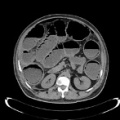Bowel perforation
Background
Bowel perforation describes a full-thickness breach of the intestinal wall, allowing air and/or gastrointestinal contents to enter the surrounding peritoneal cavity, which can be a potentially life-threatening cause of sepsis. Perforation typically presents acutely (i.e., appendicitis, diverticulitis, perforated peptic ulcer, penetrating trauma) and often requires immediate surgical intervention. However, when the perforation is immediately contained (i.e., by the omentum or retroperitoneum) it may occasionally present with a more indolent course. Similarly, immunosuppression or systemic corticosteroid therapy may blunt the inflammatory response resulting in a protracted, indolent presentation.
Clinical Features
- Primary features:
- Abdominal pain, abdominal distention/rigidity (see acute abdomen)
- Occasionally focal if regionally confined (less common)
- Nausea, vomiting, fever, and anorexia often present
- Abdominal pain, abdominal distention/rigidity (see acute abdomen)
- Secondary features:
- Sepsis (fever, leukocytosis, tachycardia, hypotension)
- Possible sepsis-related end-organ dysfunction (i.e., ARDS, renal failure)
Causes1,2
- Peptic ulcer disease
- Malignancy
- Diverticulitis
- Appendicitis
- Abdominal trauma (penetrating > blunt)
- Bowel obstruction
- Foreign body ingestion
- Necrotizing enterocolitis (premature infants)
- Iatrogenic (i.e., endoscopy)
Differential Diagnosis
- Acute myocardial infarction
- Intestinal obstruction
- Acute mesenteric ischemia
- Mesenteric venous thrombosis
- Pelvic inflammatory disease
- Tubo-ovarian abscess
- Pancreatitis
- Ruptured ectopic pregnancy
- Spontaneous bacterial peritonitis
Evaluation1,2
- Physical exam
- Perforation with peritonitis
- Abdominal tenderness, distention
- Involuntary guarding
- Rebound tenderness
- Perforation without peritonitis
- Abdominal tenderness
- Voluntary guarding
- Perforation with peritonitis
- Imaging (use only if physical exam is non-specific, exam findings of peritonitis warrant immediate surgical consultation):
- X-ray
- 3 views of the abdomen (upright, supine, and left lateral decubitus) and upright CXR
- X-ray
Subdiaphragmatic free gas. Case courtesy of Dr Rahul Kulkarni, <a href="https://radiopaedia.org/">Radiopaedia.org</a>. From the case <a href="https://radiopaedia.org/cases/21444">rID: 21444</a>.
- CT abdomen/pelvis with IV contrast (and PO contrast if possible)
- IV contrast improves soft tissue resolution in the abdomen and pelvis and improves diagnostic accuracy and should be considered even in the presence of acute kidney injury.
- PO contrast improves bowel resolution and the identification of perforation. Presence of PO contrast may help to distinguish intra-abdominal abscesses from adjacent bowel.
- CT abdomen/pelvis with IV contrast (and PO contrast if possible)
Large bowel perforation. Case courtesy of Dr Ian Bickle, <a href="https://radiopaedia.org/">Radiopaedia.org</a>. From the case <a href="https://radiopaedia.org/cases/55375">rID: 55375</a>.
Duodenal perforation. Case courtesy of Dr Ian Bickle, <a href="https://radiopaedia.org/">Radiopaedia.org</a>. From the case <a href="https://radiopaedia.org/cases/55491">rID: 55491</a>.
Management1,3-4
- Intravenous fluid resuscitation3
- Resuscitation guidelines for sepsis taken from the Surviving Sepsis Campaign 2016 recommendations:
- At least 30 mL/kg of IV crystalloid within first 3 hrs
- Initial target mean arterial pressure (MAP) of 65 mm Hg in patients with septic shock requiring vasopressors
- Guide resuscitation to normalize lactate in patients with elevated lactate levels as a marker of tissue hypoperfusion
- Resuscitation guidelines for sepsis taken from the Surviving Sepsis Campaign 2016 recommendations:
- Initiate broad-spectrum antibiotics (start as soon as possible)4
- Community-acquired: Therapy should target enteric gram-negative aerobic and facultative bacilli, obligate anaerobic bacilli, and enteric gram-positive streptococci
- Adult regimen: (for dosage, see table 1)
- Mild to moderate severity community acquired GI perforation:
- Single agent: Cefoxitin, ertapenem, moxifloxacin, tigecycline, and ticarcillin-clavulanic acid
- Combination therapy:
- Cefazolin, cefuroxime, ceftriaxone, cefotaxime, ciprofloxacin, or levofloxacin -AND-
- Metronidazole
- High risk/severity community acquired GI perforation:
- Single agent: Imipenem-cilastatin, meropenem, doripenem, and piperacillin-tazobactam
- Combination therapy: Cefepime, ceftazidime, ciprofloxacin, or levofloxacin -AND-
- Metronidazole
- Mild to moderate severity community acquired GI perforation:
- Pediatric regimen: (for dosage, see table 1)
- Community acquired GI perforation: Ertapenem, meropenem, imipenem-cilastatin, ticarcillin-clavulanate, and piperacillin-tazobactam (single-agent); Ceftriaxone, cefotaxime, cefepime, or ceftazidime, each in combination with metronidazole (combo); gentamicin or tobramycin, each in combination with metronidazole or clindamycin, and with or without ampicillin (alt. combo)
- Adult regimen: (for dosage, see table 1)
- Therapy for iatrogenic intra-abdominal infection should be driven by local microbiologic results; Broad-spectrum antimicrobial therapy should be tailored when culture and susceptibility reports become available
- Iatrogenic regimen:
- <20% Resistant Resudomonas aeruginosa, ESBL-producing Enterobacteriaceae, Acinetobacter, or other MDR GNB: Carbapenem, piperacillin-tazobactam (single-agent); Ceftazidime or cefepime, each in combination with metronidazole (combo)
- ESBL-producing Enterobacteriaceae: Carbapenem, piperacillin-tazobactam, or aminoglycoside (single-agent)
- P. aeruginosa >20% resistant to ceftazidime: Carbapenem, piperacillin-tazobactam, or aminoglycoside (single-agent)
- MRSA: Vancomycin only (single-agent)
- Iatrogenic regimen:
- Fungal infection: Antifungal therapy for patients with severe community-acquired or health care-associated infection is recommended if Candida is grown from intra-abdominal cultures (fluconazole; echinocandins for triazole-resistant species)
- Community-acquired: Therapy should target enteric gram-negative aerobic and facultative bacilli, obligate anaerobic bacilli, and enteric gram-positive streptococci
- Designate patient as NPO1
- Obtain blood and urine cultures1
- Obtain surgical consult1
Disposition1
- Obtain surgical consult
Antibiotic Dosage Information4
See Also
External Links
References
- Sabiston, David C.,Townsend, Courtney M.,eds. Sabiston Textbook Of Surgery: The Biological Basis Of Modern Surgical Practice. Philadelphia, PA : Elsevier Saunders, 2012.
- Tanner, T., Hall, B., & Oran, J. (2018). Pneumoperitoneum. Surgical Clinics of North America., 98(5), 915–932. https://doi.org/10.1016/j.suc.2018.06.004.
- Rhodes, A., Evans, L.E., Alhazzani, W. et al. Surviving Sepsis Campaign: International Guidelines for Management of Sepsis and Septic Shock: 2016. Intensive Care Med 43, 304–377 (2017). https://doi.org/10.1007/s00134-017-4683-6.
- Joseph S. Solomkin, John E. Mazuski, John S. Bradley, Keith A Rodvold, Ellie J.C. Goldstein, Ellen J. Baron, Patrick J. O'Neill, Anthony W. Chow, E. Patchen Dellinger, Soumitra R. Eachempati, Sherwood Gorbach, Mary Hilfiker, Addison K. May, Avery B. Nathens, Robert G. Sawyer, John G. Bartlett, Diagnosis and Management of Complicated Intra-abdominal Infection in Adults and Children: Guidelines by the Surgical Infection Society and the Infectious Diseases Society of America, Clinical Infectious Diseases, Volume 50, Issue 2, 15 January 2010, Pages 133–164, https://doi.org/10.1086/649554.





